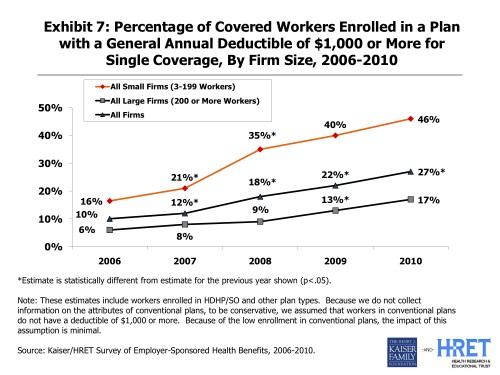Why aren't people happy about health care?
Aaron Carroll at The Incidental Economist explains some of the reasons. (That's an interesting and intelligent blog to follow, by the way.) Highlights:
--Jeff Weintraub
Every year, the Kaiser Family Foundation publishes its annual survey of Employer Health Benefits. Here’s the summary. Here’s the chart pack. Let’s wade right in.
The average premium for coverage by an employer provided health insurance plan for an individual in 2010 is $421 per month or $5,049 per year. The average premium for family coverage is $1,147 per month or $13,770 per year. [JW: Those figures include the portions paid by employers.] Think about that for a second. That’s not the Cadillac plan. That’s the average. Twenty percent of plans for families cost $16,524 or more. How has that changed over time? [....]
Health care premiums have more than doubled in the last decade. Has your salary more than doubled in the last decade? I doubt it. [JW: Actually, for the bottom 80% of households, average inflation-adjusted income has barely increased since 1979.] We are putting more and more of our income every year into health insurance premiums. Do you feel healthier? Do you feel safer? Do you feel happier? [....]
[... N]ot only are the premiums going up; so are the percentages of those premiums that individuals and families have to pay. So their costs are going up even faster than premiums are. In fact, this year was the first statistically significant increase in the percentage of premium paid by employees in a decade.
Economists will say–and they have the studies to back it up–that employees actually pay the full cost of premiums (including the “employer” share) in the form of slower wage growth. Nevertheless, few workers understand this. The perception is that only the employee share is paid by workers. But that’s gone up too, so perception and truth align. Employees are paying more.
But remember, that’s just the premium. It doesn’t include cost-sharing – things like co-pays, out of pocket costs, or deductibles. So how much are deductibles?

What this means it that even after paying for an increasing percentage of an all time high premium, more than one in four workers in an individual plan still has an annual deductible of $1000 or more. That’s a lot. [....]For the rest, including more graphs, see here.
So, benefits reduced. Cost-sharing increased. Share of premiums paid increased. Total premium cost at an all time high. And this is for employer provided health benefits, which are usually much better and cheaper than what’s available in the individual market. Depressed yet? [....]
--Jeff Weintraub


<< Home